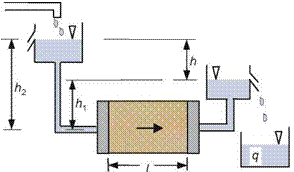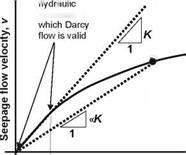Permeability Tests of Saturated Soils and Aggregates
Traditionally in geotechnical engineering, the saturated permeability is estimated in the laboratory in a constant head test for coarse grained soils whereas a falling head test is used for fine grained soils. An oedometer test can also provide a measure of the saturated permeability for fine grained soils in the laboratory. Field tests which provide a measure of the saturated permeability are usually a kind of pumping well test, or injection test.
3.3.1.1 Constant Head Permeability Test
A constant head permeability test is usually used for coarse grained soils. The sample is placed in the permeameter where a constant head drop is applied to the sample and the resulting seepage quantity is measured (see Fig. 3.5).
 |
|
By rearranging and substituting into Eq. 2.15, the permeability K is given as:
where q is the discharge (L3/T), L is the specimen length (L), A is the cross section area of the specimen (L2) and h is the constant head difference (L).
There are limitations to the use of a permeameter test for pavement materials. Sub-bases or drainage layers normally contain particles with a maximum nominal size between about 20 and 80 mm. It has been suggested that to obtain reliable permeability measurements that the value of the ratio of the permeameter diameter to the maximum particle diameter should be between 8 and 12. However, standard permeameters are generally too small and too fragile to allow the largest particles to be included and to achieve correct compaction. Head (1982) describes a 406 mm diameter permeability cell suitable for gravel containing particles up to 75 mm.
To help overcome this limitation, the UK Department of Transport (1990) introduced a large, purpose-designed, permeameter for testing road construction aggregates (Fig. 3.6). It measures horizontal permeability at low hydraulic gradients as these are the hydraulic conditions that might be anticipated in granular pavement layers.
Normally, Darcy flow is assumed to be the regime of permeating water in the soil or aggregate layers under a road, i. e. the water percolates at sub-critical velocities and without eddy-flow when moving from small to large pore spaces. This means that energy losses are only due to friction between the water and the surrounding solids and that a constant value of coefficient of permeability, K, can be defined. When coarse materials, with large pores, are tested for permeability in equipment such as that illustrated in Fig. 3.6, care must be taken to ensure that Darcy conditions are maintained throughout the test. Under many conventional test conditions, high hydraulic gradients are applied (much larger than in-situ) in order to obtain results in a convenient time scale. If such hydraulic gradients are applied to materials with large pores, eddy flows may develop in the large pores and more energy will be lost than Darcy conditions would predict. If the user is unaware of these conditions, the value of coefficient of permeability, K, will be under-estimated (see Fig. 3.7).
|
water supply
|
Ra"ge, of Darcy flow.

![]()
 gradients in Constant 9radient
gradients in Constant 9radient
Measured A response
Wrong interpretation of data point A using Darcy assumptions, leading to an underestimation of K
For this reason, tests should be performed at variable hydraulic gradients on coarse materials. Hydraulic gradients less than 0.1 may be required to achieve Darcy conditions. Alternatively, more advanced permeability formulations may be used such as those given in Eq. 2.21.







Leave a reply